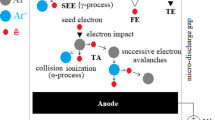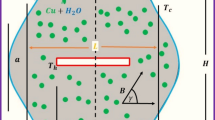Abstract
Chemical energy storage systems, e.g., in the form of hydrogen or methanol, have a great potential for the establishment of volatile renewable energy sources due to the large energy density. The efficiency of hydrogen production through water electrolysis is, however, limited by gas bubbles evolving at the electrode’s surface and can be enhanced by an accelerated bubble detachment. In order to characterize the complex multi-phase flow near the electrode, simultaneous measurements of the fluid velocities and the size and trajectories of hydrogen bubbles were performed in a water electrolyzer. The liquid phase velocity was measured by PIV/PTV, while shadowgraphy was used to determine the bubble trajectories. Special measurement and evaluation techniques had to be applied as the measurement uncertainty is strongly affected by the high void fraction close to the wall. In particular, the application of an advanced PTV scheme allowed for more precise fluid velocity measurements closer to electrode. Based on these data, stability characteristics of the near-wall flow were evaluated and compared to that of a wall jet. PTV was used as well to investigate the effect of Lorentz forces on the near-wall fluid velocities. The results show a significantly increased wall parallel liquid phase velocity with increasing Lorentz forces. It is presumed that this enhances the detachment of hydrogen bubbles from the electrode surface and, consequently, decreases the fractional bubble coverage and improves the efficiency. In addition, the effect of large rising bubbles with path oscillations on the near-wall flow was investigated. These bubbles can have a strong impact on the mass transfer near the electrode and thus affect the performance of the process.











Similar content being viewed by others
Notes
Here, \(\mathbf {j}\) and \(\mathbf {B}\) denote the current density and the magnetic induction, respectively.
The origin of the coordinate system is located at the bottom of the cathode.
The edge of the bubble curtain is only illustrated for the lowest and highest investigated current density.
The investigation was limited to low current densities as it became increasingly difficult to reliably detect bubble contours at higher current densities.
References
Aldas K, Pehlivanoglu N, Mat MD (2008) Numerical and experimental investigation of two-phase flow in an electrochemical cell. Int J Hydrog Energy 33:3668–3675. doi:10.1016/j.ijhydene.2008.04.047
Balzer BJ, Vogt H (2003) Effect of electrolyte flow on the bubble coverage of vertical gas-evolving electrodes. J Electrochem Soc 150:E11–E16. doi:10.1149/1.1524185
Boissonneau P, Byrne P (2000) An experimental investigation of bubble-induced free convection in a small electrochemical cell. J Appl Electrochem 30:767–775. doi:10.1023/A:1004034807331
Bongenaar-Schlenter BE, Janssen LJJ, van Stralen SJD, Barendrecht E (1985) The effect of the gas void distribution on the ohmic resistance during water electrolytes. J Appl Electrochem 15:537–548. doi:10.1007/BF01059295
Byrne P, Bosander P, Parhammer O, Fontes E (2000) A primary, secondary and pseudo-tertiary mathematical model of a chlor-alkali membrane cell. J Appl Electrochem 30:1361–1467. doi:10.1023/A:1026530830265
Cierpka C, Lütke B, Kähler CJ (2013a) Higher order multi-frame Particle Tracking Velocimetry. Exp Fluids 54:1533. doi:10.1007/s00348-013-1533-3
Cierpka C, Scharnowski S, Kähler CJ (2013b) Parallax correction for precise near-wall flow investigations using particle imaging. Appl Opt 52:2923–2931. doi:10.1364/AO.52.002923
Delauré YMC, Chan VSS, Murray DB (2003) A simultaneous PIV and heat transfer study of bubble interaction with free convection flow. Exp Thermal Fluid Sci 27:911–926. doi:10.1016/S0894-1777(03)00070-0
Diao Z, Dunne PA, Zangari G, Coey JMD (2009) Electrochemical noise analysis of the effects of a magnetic field on cathodic hydrogen evolution. Electrochem Commun 11:740–743. doi:10.1016/j.elecom.2009.01.020
Donnelly B, Murray DB, O’Donovan TS (2008) Bubble enhanced heat transfer from a vertical heated surface. J Enhanc Heat Transf 15:159–169. doi:10.1615/JEnhHeatTransf.v15.i2.50
Donoghue DB, Donnelly B, Murray DB (2012) The enhancement effects of a plume of rising bubbles on natural convection from a heated vertical plate. J Enhanc Heat Transf 19:379–395. doi:10.1615/JEnhHeatTransf.004080
Duncan J, Dabiri D, Hove J, Gharib M (2010) Universal outlier detection for particle image velocimetry (PIV) and particle tracking velocimetry (PTV) data. Meas Sci Technol 21:057002. doi:10.1088/0957-0233/21/5/057002
Eigeldinger J, Vogt H (2000) The bubble coverage of gas-evolving electrodes in a flowing electrolyte. Electrochim Acta 45:4449–4456. doi:10.1016/S0013-4686(00)00513-2
Farmer MG (1885) Apparatus for refining copper by electricity. US patent 322,170
Fukunaka Y, Suzuki K, Ueda A, Kondo Y (1989) Mass-transfer rate on a plane vertical cathode with hydrogen gas evolution. J Electrochem Soc 136:1002–1009. doi:10.1149/1.2096773
Hieber CA, Gebhart B (1971) Stability of vertical natural convection boundary layers: some numerical solutions. J Fluid Mech 48(4):625–646. doi:10.1017/S0022112071001770
Hine F, Murakami K (1980) Bubble effects on the solution IR drop in a vertical electrolyzer under free and forced convection. J Electrochem Soc 127:292–297. doi:10.1149/1.2129658
Hine F, Yasuda M, Nakamura R, Noda T (1975) Hydrodynamic studies of bubble effects on the iR-drops in a vertical rectangular cell. J Electrochem Soc 122:1185–1190. doi:10.1149/1.2134422
Iida T, Matsushima H, Fukunaka Y (2007) Water electrolysis under a magnetic field. J Electrochem Soc 154:E112–E115. doi:10.1149/1.2742807
Kitagawa A, Murai Y (2014) Pulsatory rise of microbubble swarm along a vertical wall. Chem Eng Sci 116:694–703. doi:10.1016/j.ces.2014.06.001
Kitagawa A, Hagiwara Y, Kouda T (2007) PTV investigation of phase interaction in dispersed liquid–liquid two-phase turbulent swirling flow. Exp Fluids 42:871–880. doi:10.1007/s00348-007-0291-5
Kölbel H, Siemes W, Maas R, Müller K (1958) Wärmeübergang an Blasensäulen. Chem Ing Tech 30:400–404. doi:10.1002/cite.330300606
Koza JA, Mühlenhoff S, Żabiński P, Nikrityuk PA, Eckert K, Uhlemann M, Gebert A, Weier T, Schultz L, Odenbach S (2011) Hydrogen evolution under the influence of a magnetic field. Electrochim Acta 56:2665–2675. doi:10.1016/j.electacta.2010.12.031
Kuroda I, Sakakibara A, Sasaki T, Murai Y, Nagai N, Yamamoto F (2008) PIV study on Buoyant bubble flows in a small electrolytic cell. Jpn J Multiphase Flow 22:161–174. doi:10.3811/jjmf.22.161
Matsushima H, Kiuchi D, Fukunaka Y (2009) Measurement of dissolved hydrogen supersaturation during water electrolysis in a magnetic field. Electrochim Acta 54:5858–5862. doi:10.1016/j.electacta.2009.05.044
Matsushima H, Iida T, Fukunaka Y (2012) Observation of bubble layer formed on hydrogen and oxygen gas-evolving electrode in a magnetic field. J Solid State Electrochem 16:617–623. doi:10.1007/s10008-011-1392-x
Matsushima H, Iida T, Fukunaka Y (2013) Gas bubble evolution on transparent electrode during water electrolysis in a magnetic field. Electrochim Acta 100:261–264. doi:10.1016/j.electacta.2012.05.082
Monzon LMA, Coey JMD (2014) Magnetic fields in electrochemistry: the Lorentz force: a mini-review. Electrochem Commun 42:38–41. doi:10.1016/j.elecom.2014.02.006
Nagai N, Takeuchi M, Kimura T, Oka T (2003) Existence of optimum space between electrodes on hydrogen production by water electrolysis. Int J Hydrogen Energy 28:35–41. doi:10.1016/S0360-3199(02)00027-7
Ohmi K, Li HY (2000) Particle-tracking velocimetry with new algorithms. Meas Sci Technol 11:603–616. doi:10.1088/0957-0233/11/6/303
Pletcher D, Li X (2011) Prospects for alkaline zero gap water electrolysers for hydrogen production. Int J Hydrogen Energy 36:15089–15104. doi:10.1016/j.ijhydene.2011.08.080
Roald B, Beck W (1951) The dissolution of magnesium in hydrochloric acid. J Electrochem Soc 98:277–290. doi:10.1149/1.2778207
Schillings J, Doche O, Deseure J (2015) Modeling of electrochemically generated bubbly flow under buoyancy-driven and forced convection. Int J Heat Mass Transf 85:292–299. doi:10.1016/j.ijheatmasstransfer.2015.01.121
Schrader LU, Mavripilis C, Brandt L (2012) Spatial linear disturbances in a plane wall jet. Phys Fluids 24:054104. doi:10.1063/1.4717954
Sides PJ (1986) Phenomena and effects of electrolytic gas evolution. In: White R, Bockris J, Conway B (eds) Mod Asp Electrochem, vol 18. Plenum Press, New York, pp 303–354. doi:10.1007/978-1-4613-1791-3_6
Sillen C (1983) The effect of gas bubble evolution on the energy efficiency in water electrolysis. PhD thesis, TU Eindhoven
Sillen C, Barendrecht E, Janssen L, van Stralen S (1982) Gas bubble behaviour during water electrolysis. Int J Hydrogen Energy 7:577–587. doi:10.1016/0360-3199(82)90038-6
Sutija DP, Tobias CW (1994) Mass-transport enhancement by rising bubble curtains. J Electrochem Soc 141:2599–2607. doi:10.1149/1.2059128
Tagawa Y, Takagi S, Matsumoto Y (2014) Surfactant effect on path instability of a rising bubble. J Fluid Mech 738:124–142. doi:10.1017/jfm.2013.571
van Wijngaarden L (1998) On pseudo turbulence. Theoret Comput Fluid Dyn 10:449–458. doi:10.1007/s001620050076
Vogt H (1983) Gas-evolving electrodes. In: Yeager E, Bockris J, Conway B, Sarangapani S (eds) Electrodics: transport, comprehensive treatise of electrochemistry, vol 6. Plenum Press, Ney York, pp 445–489. doi:10.1007/978-1-4615-6690-8_7
Vogt H, Stephan K (2015) Local microprocesses at gas-evolving electrodes and their influence on mass transfer. Electrochim Acta 155:348–356. doi:10.1016/j.electacta.2015.01.008
Wang M, Wang Z, Gong X, Guo Z (2014) The intensification technologies to water electrolysis for hydrogen production—a review. Renew Sustain Energy Rev 29:573–588. doi:10.1002/chin.201433287
Weier T, Landgraf S (2013) The two-phase flow at gas-evolving electrodes: bubble-driven and Lorentz-force-driven convection. Eur Phys J Spec Top 220:313–322. doi:10.1140/epjst/e2013-01816-1
Whitney G, Tobias CW (1988) Mass-transfer effects of bubble streams rising near vertical electrodes. AIChE J 34:1981–1995. doi:10.1002/aic.690341207
Zenit R, Koch DL, Sangani AS (2001) Measurements of the average properties of a suspension of bubbles rising in a vertical channel. J Fluid Mech 429:307–342. doi:10.1017/S0022112000002743
Acknowledgments
Financial support from the DFG under the grant number CI 185 ‘Kontrollierte elektrochemische Energieumwandlung durch oberflächennahe Strömungsbeeinflussung’ is gratefully acknowledged.
Author information
Authors and Affiliations
Corresponding author
Rights and permissions
About this article
Cite this article
Baczyzmalski, D., Weier, T., Kähler, C.J. et al. Near-wall measurements of the bubble- and Lorentz-force-driven convection at gas-evolving electrodes. Exp Fluids 56, 162 (2015). https://doi.org/10.1007/s00348-015-2029-0
Received:
Revised:
Accepted:
Published:
DOI: https://doi.org/10.1007/s00348-015-2029-0




